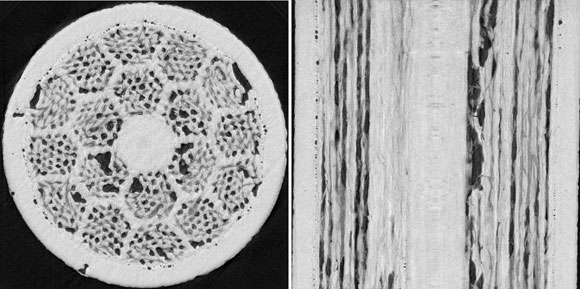- Home
- Industry
- Industry news
- Superconducting...
Superconducting wires, better without bubbles
23-06-2011
Bubbles formed in filaments of a superconducting wire during fabrication have a negative effect on the critical current density of the final product. In situ X-ray tomography studies of the fabrication process permitted the evolution of the bubbles to be visualised. Eliminating bubble formation during the early stages of manufacture would be a way to improve future superconducting wires.
Share
The challenge
To carry out a combined in-situ microstructural and phase characterisation of multi-filament Bi2Sr2CaCu2Ox (Bi2212) wires to monitor in detail the formation of bubbles.
Background
Bi2212 is the only high temperature superconductor that can be made in the form of wires. It has potential applications such as very high field continuous superconducting magnets. Melt processing of the powder (Bi2212) in tube (Ag) wires at temperatures above 880°C and specific cooling ramps are necessary to obtain high critical current densities Jc. The critical current density is known to be limited by the connectivity within the filaments.
Synchrotron techniques
Combined synchrotron absorption microtomography and X-ray diffraction during in-situ processing heat treatments was used to image the wires in 3D, as well as monitoring the phase evolution.
Results
The scientists could monitor the void and phase evolution throughout all stages of the Bi-2212 heat treatment process in much greater detail than has ever been available before. The tomograms show clearly the coalescence of the finely dispersed porosity and how voids continue to grow dramatically when the Bi-2212 phase melts. The porosity that remains after cooling and Bi-2212 solidification clearly has the potential to suppress current paths in the complete filament.
How did the synchrotron experiment help?
The high flux and high energy of the X-rays at ID15 permitted rapid tomograms of the highly-absorbing Bi2212 wires. With such fast acquisition time, it was possible to study the structure of the filaments while the wire was being processed using in situ heat treatments. The non-destructive X-ray studies allow for a detailed observation of the void and phase evolution, and a quantitative description of the void volume. The X-ray studies complemented other analytical methods such as SEM, for which the samples underwent potentially destructive preparation such as cutting, polishing and etching.
Industrial collaborator
Oxford Superconducting Technology, Carteret (USA)
Further information
Bubble formation within filaments of melt-processed Bi2212 wires and its strongly negative effect on the critical current density, F. Kametani, T. Shen, J. Jiang, C. Scheuerlein, A. Malagoli, M. Di Michiel, Y. Huang, H. Miao, J.A. Parrell, E.E. Hellstrom and D.C. Larbalestier, Supercond. Sci. Technol. 24, 075009 (2011).




